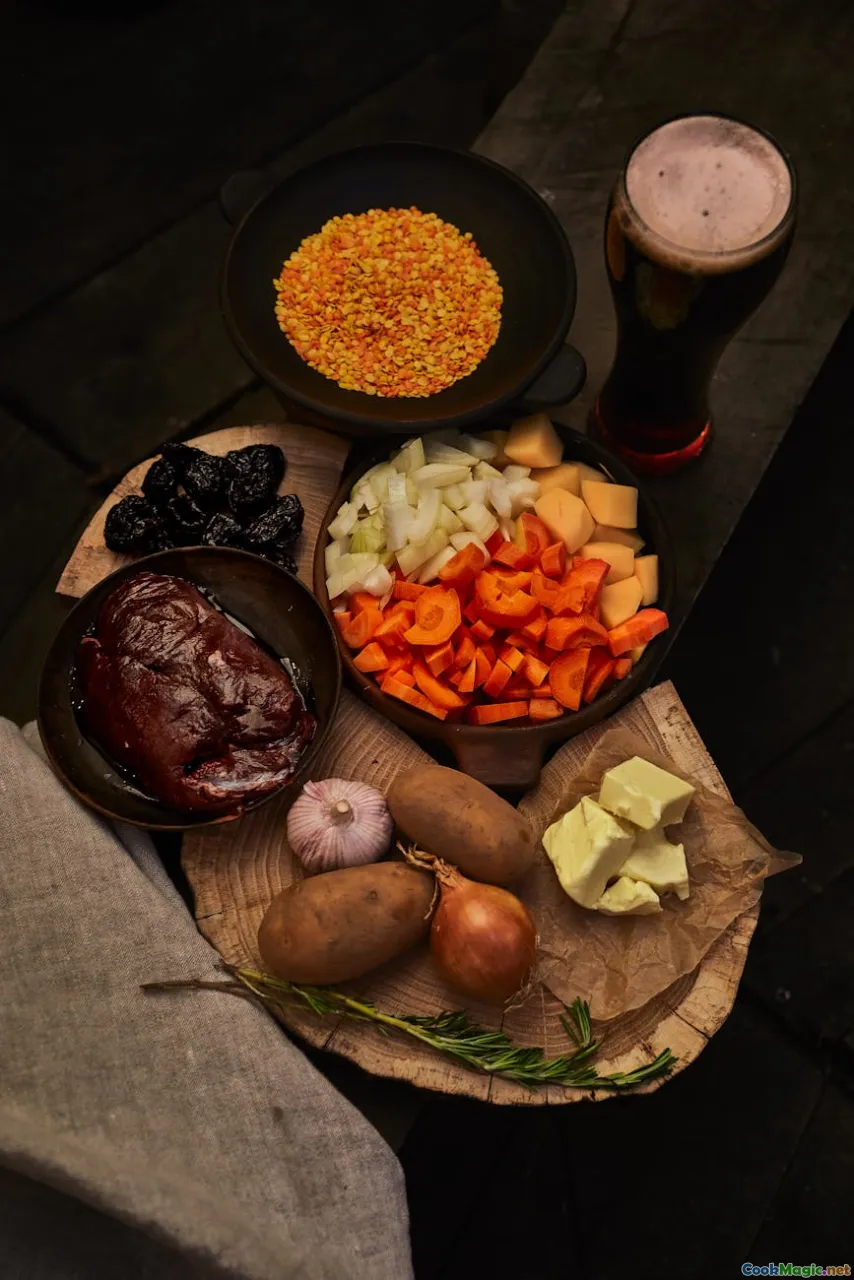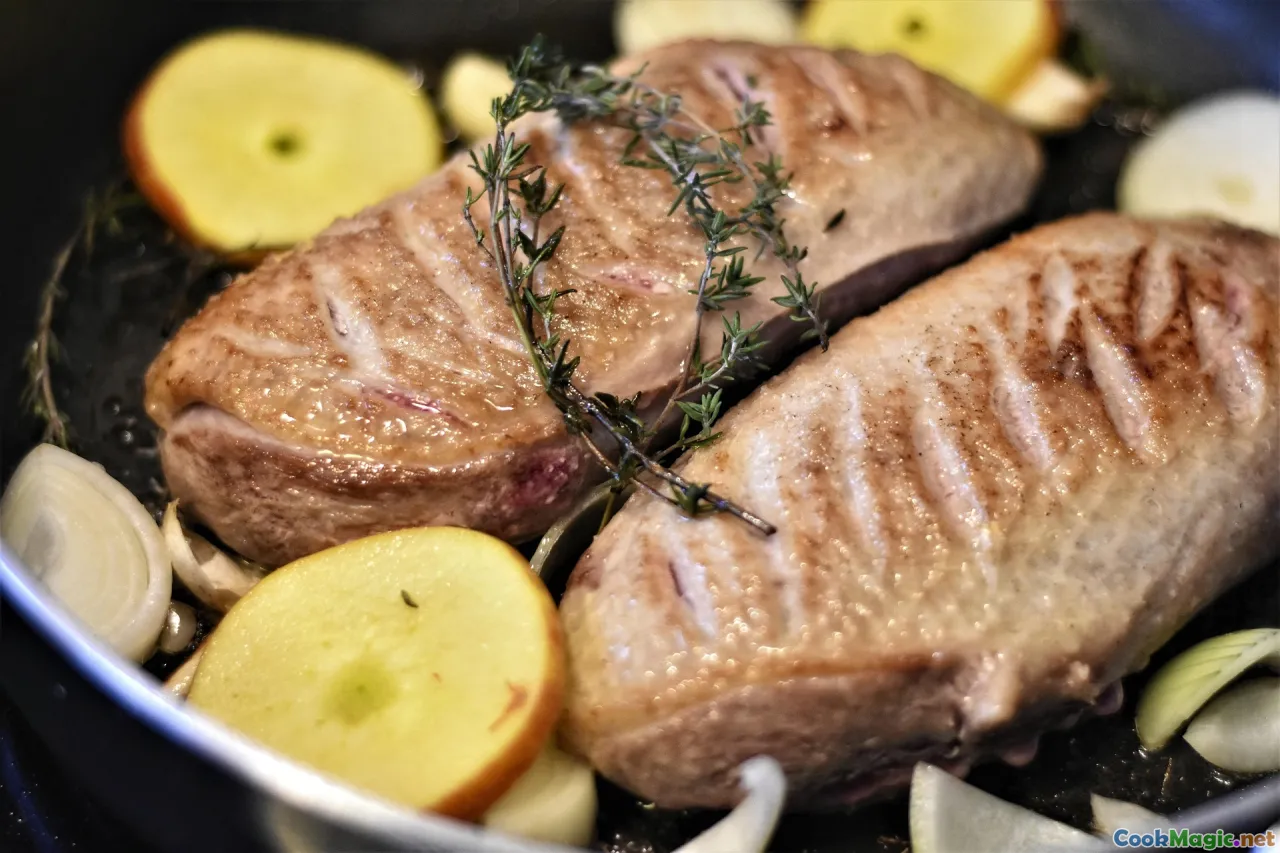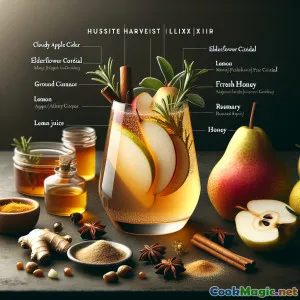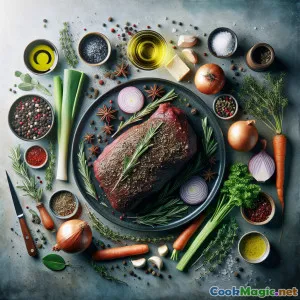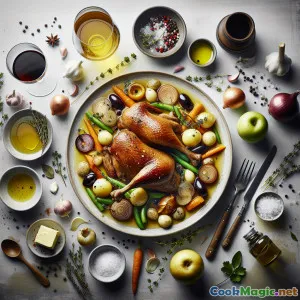
Stufato di Anatra e Cipolle in Inglese: Pato Encebollado
(English Duck & Onion Stew: Pato Encebollado)
(0 Recensioni)0
1,129
luglio 18, 2025
Segnala un problema
Ingredienti
-
4 pieces cosce di anatra
(Con la pelle per un sapore più ricco.)
-
3 large Cipolle gialle
(Affettato sottile)
-
2 medium Scalogno
(Affettato sottile)
-
250 ml Sidro di mele inglese
(Secco, non dolce)
-
700 ml brodo di pollo
(Preferito a basso contenuto di sodio)
-
3 cloves Aglio
(Schiacciato)
-
2 leaves Foglie di alloro
-
4 sprigs Timo Fresco
-
2 medium Carote
(Pelato e tagliato a cubetti)
-
2 pieces Gambi di sedano
(tritato finemente)
-
100 grams Fave
(sgusciato)
-
2 tbsp Burro non salato
-
1 tbsp Olio d'oliva
-
1 tsp Sale marino
(A piacere)
-
0.5 tsp Pepe nero
(Macinato fresco)
-
2 tbsp Prezzemolo fresco
(Tritato, per guarnire)
(Con la pelle per un sapore più ricco.)
(Affettato sottile)
(Affettato sottile)
(Secco, non dolce)
(Preferito a basso contenuto di sodio)
(Schiacciato)
(Pelato e tagliato a cubetti)
(tritato finemente)
(sgusciato)
(A piacere)
(Macinato fresco)
(Tritato, per guarnire)
Nutrizione
- Porzioni: 4
- Dimensione Porzione: 1 ciotola sostanziosa (350 g)
- Calories: 594 kcal
- Carbohydrates: 24 g
- Protein: 38 g
- Fat: 34 g
- Fiber: 6 g
- Sugar: 11 g
- Sodium: 983 mg
- Cholesterol: 153 mg
- Calcium: 61 mg
- Iron: 6.9 mg
Istruzioni
-
1 - Rosolare l'anatra:
Tampona bene le cosce d'anatra e conditele generosamente. Scalda una grande pentola olandese a fuoco medio-alto, aggiungi olio d'oliva e rosola le cosce d'anatra, con la pelle rivolta verso il basso, per circa 7 minuti per lato. Rimuovi e metti da parte.
-
2 - Caramellare le cipolle:
Riduci la fiamma a medio. Aggiungi burro, cipolle e scalogno. Soffriggi lentamente, mescolando spesso, finché non saranno profondamente caramellizzate, circa 15 minuti.
-
3 - Costruisci la base:
Aggiungi l'aglio, le carote e il sedano. Cuoci per 5 minuti finché non si ammorbidiscono. Unisci le foglie d'alloro e il timo.
-
4 - Sfumare e lasciare sobbollire:
Versa il sidro, raschiando via tutti i pezzi dorati attaccati al fondo. Lascia sobbollire per 2 minuti. Riporta le cosce d'anatra nel tegame.
-
5 - Fai sobbollire lo stufato:
Versa il brodo e le fave. Copri e lascia sobbollire a fuoco basso per 45-50 minuti, finché l’anatra non sarà tenera e la salsa si sarà addensata. Mescola di tanto in tanto.
-
6 - Condire e completare:
Scarta foglie d'alloro e rametti di timo. Assaggia la preparazione e, se necessario, aggiungi sale, pepe o sidro a piacere. Spolvera prezzemolo prima di servire.
Tampona bene le cosce d'anatra e conditele generosamente. Scalda una grande pentola olandese a fuoco medio-alto, aggiungi olio d'oliva e rosola le cosce d'anatra, con la pelle rivolta verso il basso, per circa 7 minuti per lato. Rimuovi e metti da parte.
Riduci la fiamma a medio. Aggiungi burro, cipolle e scalogno. Soffriggi lentamente, mescolando spesso, finché non saranno profondamente caramellizzate, circa 15 minuti.
Aggiungi l'aglio, le carote e il sedano. Cuoci per 5 minuti finché non si ammorbidiscono. Unisci le foglie d'alloro e il timo.
Versa il sidro, raschiando via tutti i pezzi dorati attaccati al fondo. Lascia sobbollire per 2 minuti. Riporta le cosce d'anatra nel tegame.
Versa il brodo e le fave. Copri e lascia sobbollire a fuoco basso per 45-50 minuti, finché l’anatra non sarà tenera e la salsa si sarà addensata. Mescola di tanto in tanto.
Scarta foglie d'alloro e rametti di timo. Assaggia la preparazione e, se necessario, aggiungi sale, pepe o sidro a piacere. Spolvera prezzemolo prima di servire.
Ulteriori informazioni su: Stufato di Anatra e Cipolle in Inglese: Pato Encebollado
Pato Encebollado – An English Duck & Onion Stew
Pato Encebollado is a unique fusion dish marrying the rustic heartiness of English stews with the Iberian romance of its Spanish namesake, which translates literally to 'Duck with Onions.' While dishes incorporating duck and slow-cooked onions are beloved across the globe, this reinterpretation draws especially from the English countryside—where robust, slow-cooked fare is a way of life.
History & Inspiration
The tradition of onion-laden stews can be traced from medieval England’s cookery all the way to Spanish family kitchens. Duck, once a prized and readily available wild fowl, made a frequent appearance in British gastronomy before the popularity of game waned slightly with modern farming.
Pato Encebollado here finds its English twist through the use of dry apple cider (a nod to rustic British drinks and their familiar presence in autumn dishes) and the classic combi of carrots, celery, and herbs famous in English stewing. The technique remains classic: browning to develop flavor, slow cooking for tenderness, and finishing with garden-fresh parsley, echoing the heartiness of a pub meal.
Tips & Unique Aspects
-
Duck Tips: Leaving the skin on imparts deep flavor and helps retain moisture during the long simmer. Be sure to brown well for both color and taste boost.
-
Onion Magic: Caramelizing the onions properly is the backbone of this dish. Don’t rush—the slow, gentle cooking brings out their inherent sweetness and pairs beautifully against the rich duck and the brisk tang from cider.
-
Cider Selection: A traditional English dry cider maximizes the savory potential. If dry cider isn't available, a tart apple juice, mixed with a bit of white vinegar, can be substituted for similar effect.
-
Herbage: Use fresh thyme for its perfume, and feel free to chuck in fresh rosemary in the last minutes of cooking. The broad beans (fava) are a subtle nod to English garden abundance, but may be omitted for balance or availability.
risadvanti recommended served over a heap of buttery mashed potatoes, piping hot bread, or steamed root veg. For festive table dressing, scatter over extra herbs, sliced green onions, and zest from a local apple.
Cultural Significance
Pato Encebollado is comfort food for chilly northern latitudes, suited to long afternoons with friends and a glass of the stew’s contributing cider. Its fusion appeal also makes it a wonderful centerpiece for Anglo-Spanish suppers—an edible bridge between European traditions. In a pub or at home by the fire, it’s the kind of stew that brings people together in conversation and warmth.
Notes on Nutrition
Duck is surprisingly nutritious as part of a rotated diet, providing robust iron, rich flavor, and B vitamins. The addition of starchy root veg, hearty beans, and a sensible fat balance from olive oil and duck fat make this a well-rounded meal, especially satisfying on weekends or as a holiday treat.
A Final Thought
English cuisine has long excelled at honest, slow-simmered stews—meals fostered by patience, local produce, and appetite. With Pato Encebollado, allow yourself the pleasure of time, descend with friends and family into the heady aroma of onions and duck quietly bubbling, and savor the complex interplay that emerges after nearly two hours of gentle transformation.
Garnish boldly, serve enthusiastically, and let tales and laughter linger over this bowled tapestry of English cooking—a truly distinctive duck stew worth discovering again and again.

